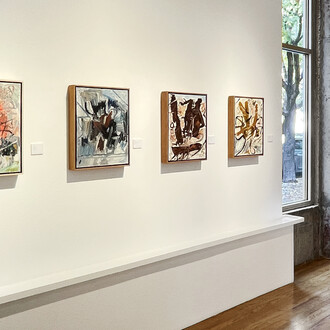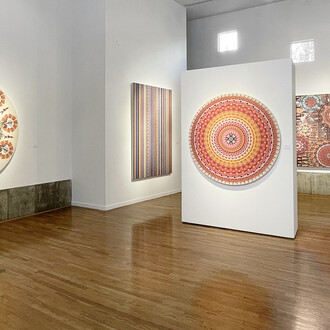In her first extensive solo exhibition with Robischon Gallery, California artist Amy Ellingson presents her highly complex, massive and small-scale oil/encaustic paintings, prints and objects to mesmerizing effect. Captivating the eye, while visually in conversation with art historical movements such as Postmodernism and the many off-shoots of Abstract Expressionism, the pace and intensity of the Digital Age is fully embraced within Ellingson’s work. The artist’s visual language with its potential for endless variations in line and form, recalls a sense of the alphabetic and hieroglyphic, while eluding to worlds both known and unknown, immediate and distant. Ellingson’s inspiration for her latest series, beginning with its title “Sweetbitter Beast” is a reference to the ancient Greek poet Sappho, in specific Sappho’s “Fragment 130”, translated by Willis Barnstone: Eros loosener of limbs once again trembles me, a sweetbitter beast irrepressibly creeping in. This poetic excerpt speaks to both a complexity and ambivalence, which ignited a response in Ellingson “to encompass and hold a fierce confrontation of opposing formal elements in equilibrium” within this body of work. Employing primarily brilliant color in contrast to the constant of a foundational white, along with the profusion of unexpected form and her mastery of a highly-challenging medium, Ellingson’s distinctive approach in this exhibition, as in all of her work, is hard won and rooted in the conceptual.
Best conveyed in Ellingson’s own words, she generously writes about her process and intent, “My work exaggerates the dichotomy between the lightning-fast process of digital rendering and the painstaking method of execution through traditional oil and encaustic painting techniques. All of my imagery, whether geometrically intact or abstracted and chaotic, comprises a vocabulary of very simple forms that are digitally manipulated. The paintings consist of many interrelated layers of repeating geometric forms—straight lines and arcs, primarily—that I compose on the computer. I replicate these basic elements into an increasingly complex field that I then render in discreet layers of oil and encaustic paint. Using ephemeral, computer-generated images exclusively as my source material, I create paintings that physically assert themselves through the materiality and permanence of historical painting media. The translation from the ‘virtual’ to the ‘real’ is paramount and my interests lie in the practices of formal repetition, variation and mutation within limited serial networks. The works are created through a series of steps intended to conflate the systemic and the gestural. Working within a self-reflexive system—borrowing, distorting, manipulating, copying and pasting, re-contextualizing—I create a personal language that is hermetic, yet flexible and mutable. Digital tools enable me to develop a vocabulary of forms that are used, grabbed, reused, and manipulated beyond recognition, resulting in a signature vernacular of marks that are predetermined via digital processing.”
A sense of scale is very important to Ellingson. For each solo exhibition, the artist dutifully builds highly detailed scale models, and designs entire exhibitions for specific spaces – as she enjoys the idea of the exhibition as an idealized, singular presentation. Ellingson deeply considers scale for each new work and as she has utilized the large, elongated horizontal rectangle for many years she notes that for her it recalls epic mid-century painting, billboards and movie screens - and reveals a high level of commitment, ambition and seriousness of purpose. For each new composition, Ellingson further considers the size and proportions of the piece – the smaller, square-format works are compact and dense, while her recognized long horizontal works convey a sense of spatial illusion and motion. For each individual painting, Ellingson maintains a language of pure abstraction, while using the computer as her chosen tool to appropriate and repurpose aspects of her own work. She then selects and alters her simple geometric forms from her earlier files into new configurations; resulting in a vocabulary of marks, which are at once personal and impersonal, created by formal decisions as interpreted by her computer graphics program. Once compositionally resolved, she begins the lengthy process of translating it into a dimensional, material object using oil and encaustic on panel – though there are numerous procedural steps and points of translation between the digital rendering and the final painting. On its route from sketch to painting, Ellingson enhances the imagery through her dedication of time, attention, materiality and physical energy. She states, “My goal is to create works that address the intersection of abstract painting and contemporary virtual experience.”
Evident in every aspect of her studio practice and exhibition planning, is Ellingson’s complete commitment toward each required step. It is not uncommon for the artist to commit to three-hundred to seven-hundred hours in the studio to complete one large painting. She believes that the mindful labor required to create each of her works offer her the opportunity for a transcendent experience within the process. The ordering of each layer and the subtle to exuberant color formulas are ultimately manifested on the surface by the artist’s own hand as Ellingson directs which shapes to recede and which to elevate. This range of distancing, reflecting each painting’s conception and slow physical making is essentially what locates it firmly within the contemporary realm – in contrast, for example, to the more immediate and generally recognized gestural mark-making or poured/dripped canvases of those artists from the Abstract Expressionist movement. While connections or references to the all-over and encompassing paintings of AB EX giant Jackson Pollock may be recalled in some cases, Ellingson’s paint applications and conceptual processes are decidedly current and of this time.
Ellingson’s inherent methodical sensibilities and dogged visual pursuit, naturally led the artist to explore other mediums such as prints and sculptural installations. The three prints on exhibit are part of a suite of four and represent the artist’s first major foray into printmaking. She sought to use the layering potential of printmaking to achieve something akin to her Identical/Variation series of interrelated groups of paintings that she has created off and on over the last decade. Each print in the suite comprises: an etching in black ink, vibrant acrylic color, and the final layer, a laser-etched intaglio woodcut, printed in a series of four different colors, categorized as black, blue, green and red, in variable orientation. The prints employ a high degree of back and forth between digital and traditional processes and possess an atmospheric quality due to their level of detail and the density of the imagery that is very different from the paintings.
Regarding the artist’s sculptural Installation, composed of cast encaustic forms, Ellingson reveals, “Variation (a configuration of forces): Artifacts is a sculptural version of the two large paintings. The multitude of shapes in the planar field of the paintings have been deconstructed, piece by piece, to suggest physical detritus, as if individual elements have been wrenched from the intact works, gaining a presence apart from the context of the picture plane. They are rough, crude imaginings: artifacts, vestiges or debris, liberated from the vertical plane. While I try to capture the ‘feel’ of the paintings, I am not too literal about reproducing particular shapes in full; rather, I tend to think of the forms as fragmented. I compose the arrangement intuitively, while looking at the paintings, arranging the shapes and colors in the general order of the construction of the paintings. I try to achieve a sense of resemblance that allows viewers to make a connection between the painting, which is on a vertical plane, and the installation, which is on a horizontal plane. I hope to create a dynamism between 2-D and 3-D and between vertical and horizontal.”
Amy Ellingson offers the viewer an encompassing and endlessly fascinating optical experience, one in which the floating forms on white grounds and bright swaths of saturated color appear to somehow slowly move in relation to the level of attention or focus given. The artist summarizes, “For this exhibition, the three elements (paintings, prints and sculpture) may be viewed within the context of a creative cosmology, with the works relaying the same basic informational ‘code’ with varying degrees of digital and material mediation. Together, the works address issues of construction and deconstruction and the multiplicity of expressive possibilities within a limited system.”
Amy Ellingson received her B.A. from Scripps College in Claremont, CA and M.F.A. from California Institute of the Arts. Her paintings have been exhibited in Japan and widely exhibited nationally, from New York, to Colorado to California. She is the recipient of the Fleishhacker Foundation Eureka Fellowship and the Artadia Grant to Individual Artists and has been awarded fellowships at the MacDowell Colony, the Ucross Foundation, and the Civitella Ranieri Foundation. Her work is included in the permanent collections of The Achenbach Foundation for Graphic Arts, San Francisco, CA, The Paul Allen Collection, Seattle, WA, Bank of America, Charlotte, NC, Berkeley Art Museum, Berkeley, CA, City and County of San Francisco, CA, Community Hospital of the Monterey Peninsula, Monterey, CA, The Contemporary Museum, Honolulu, HI, Crocker Art Museum, Sacramento, CA, Hewlett-Packard Corporation, Palo Alto, CA, Monterey Museum of Art, Monterey, CA, Oakland Museum of California, Oakland, CA, San Francisco Museum of Modern Art, San Francisco, CA, San Jose Museum of Art, San Jose, CA, Twitter, Inc., San Francisco, CA, United Sates Embassy, Algeria, and United States Embassy, Tunisia. Notable group exhibitions include Bay Area Now 3 at Yerba Buena Center for the Arts; Neo Mod: Recent Northern California Abstraction at the Crocker Art Museum; and Nineteen Going on Twenty: Recent Acquisitions from the Collection at The Contemporary Museum, Honolulu. Ellingson’s recent public commission entitled Untitled (Large Variation), is permanently on view in Terminal 3 at San Francisco International Airport. Concurrently, Ellingson’s work was most recently featured in group exhibitions at Newcomb Art Museum of Tulane University in New Orleans, LA and Bedford Gallery at the Lesher Center for the Arts in Walnut Creek, CA in 2017.
















